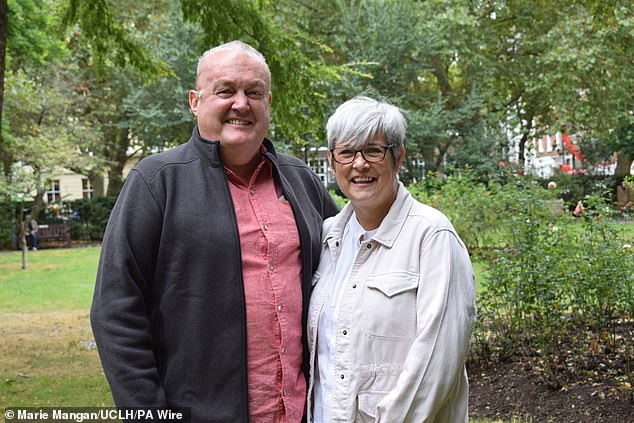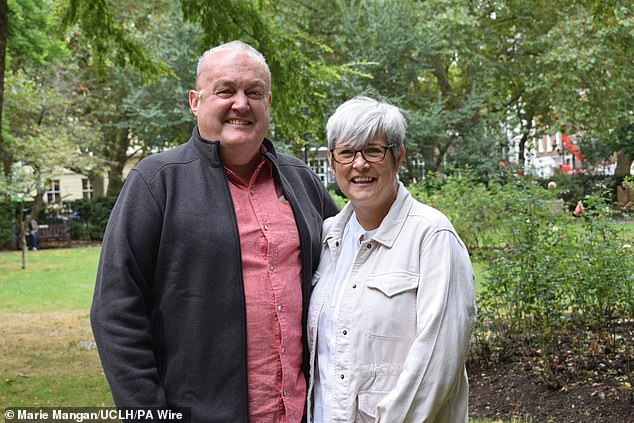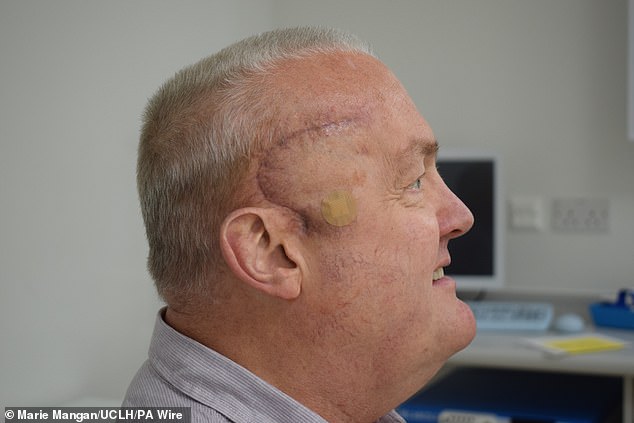Man, 62, sees fatal brain tumor shrink by half within weeks – but HOW did that happen?



A man has seen his fatal brain tumor shrink by half thanks to a new radioactive therapy that experts hope will eradicate the disease.
Doctors at University College London Hospitals NHS Foundation Trust (UCLH) are conducting a clinical trial to treat glioblastoma.
About 3,200 people are diagnosed with the disease each year, the most common type of brain tumor in adults.
Most patients die within 18 months and only 5 percent live five years.
The researchers’ goal is to cure the disease by injecting low levels of radioactivity directly into the tumor to kill cancer cells.

Paul Read has seen his fatal brain tumor shrink by half thanks to a new radioactive therapy that experts hope will eradicate the disease. Here Mr Read is pictured with his wife Pauline

The 62-year-old engineer from Luton is the first patient to take part in the trial and has seen his tumor shrink by half in just a few weeks. For the procedure, surgeons removed as much tumor as possible before implanting a small medical device called an Ommaya reservoir under the scalp, which connects to the tumor via a small tube.
Paul Read, a 62-year-old engineer from Luton, is the first patient to take part in the trial and has seen his tumor shrink by half in just a few weeks.
A second patient has also just started therapy.
For the procedure, surgeons removed as much tumor as possible before implanting a small medical device called an Ommaya reservoir under the scalp, which connects to the tumor via a small tube.
The UCLH nuclear medicine team then injects a drug – ATT001, an iodine-123-labeled PARP inhibitor – directly into the tumor, releasing small amounts of radioactivity.
The drug, given weekly for four to six weeks, is very potent over short distances and causes lethal damage to tumor cells while sparing healthy tissue.
Mr Read, who has recurrent glioblastoma, first noticed a very severe headache last December that did not go away.
After being diagnosed and having surgery two days after Christmas to remove as much of the tumor as possible, Mr. Read follow-up courses of radiotherapy and chemotherapy.
But doctors told him in July that his tumor was growing again.
Mr Read was subsequently offered a place in the new CITADEL-123 trial at UCLH, having previously agreed to participate in clinical research.
He said: ‘I fully expected the tumor to return due to its aggressive nature. I know the result isn’t great and I was happy to explore something different.
‘This trial was a lifeline because the data showed the survival rate for me was one year or less.
‘I am happy to have the opportunity to be part of this trial and I have not experienced any side effects from the injections.
‘Maybe a little more tired, but overall I feel very good.
‘I’m not afraid of this. We each get a handful of cards and you don’t know which one you’ll get.
‘It will be great if this treatment helps me and if it doesn’t, then it won’t. I am more than satisfied; even if it doesn’t benefit me, it could benefit someone else later.
“So I have nothing to lose and everything to hope for.”
UCLH consultant medical oncologist Dr Paul Mulholland, who designed the trial, said: ‘We must aim to cure this disease. There are reasons why we can cure it, because this disease occurs in the same location in the brain.
‘Primary brain tumors do not spread throughout the body and generally stay in the same place in the brain.
‘It does not spread to the rest of the body, so a targeted approach – directly into the tumor – makes sense.’




